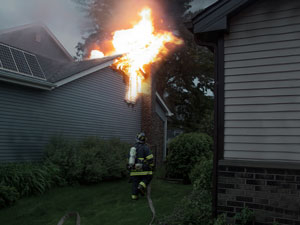Electrical and Chemical Risks
The following are some electrical and chemical risks that you may face in a PV system incident.
- Shock hazards: All PV equipment can potentially produce voltage, even when damaged and in the absence of sunlight. Any type of light could potentially activate the system. Even a system that has been shut down is not necessarily safe. Always consider all PV equipment energized and dangerous. The risk of electrical shock is high in these situations, and injury or death can occur.
- Toxins and carcinogens: If PV equipment degrades in a fire or explosion, hazardous chemicals (such as cadmium telluride, gallium arsenide, and phosphorous) may be released. These toxic and/or carcinogenic substances pose a serious inhalation hazard.
- Surges and arcing: Most PV system incidents involve power surges and/or arcing. This often compromises the integrity of components and insulation throughout the system, increasing the risks of electrical shock and exposure to products of combustion. Once an arc or other thermal failure occurs, all system components should be considered dangerous.
- Battery hazards: Batteries can release corrosive, toxic, and flammable substances (such as hydrogen gas) if they overheat, ignite, or become damaged. Of course, they also pose a shock hazard from the dangerous amounts of electricity they contain.

